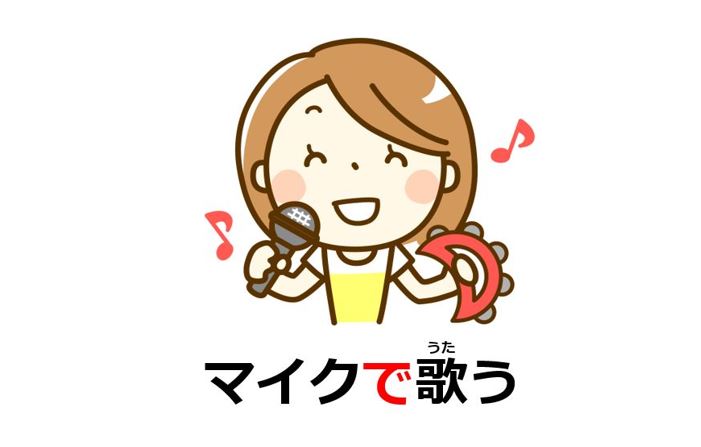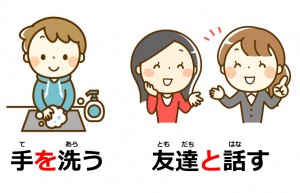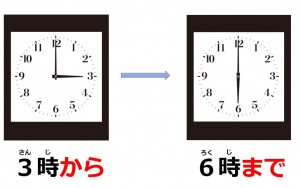Last time, you learned how to use objects with Japanese verbs, like 本を読みます. Then, if you say, “I will read books at the library,” what should it be like? Here, you will learn how to give more contexts by using the particle で.
Explanation for How the Particle で Works
| Table of Contents Location of Action Material Means Reason (Causation) Range (Period of Time) Amount State |
You have learned three sentence structures so far, which are (1) State-of-Being: 私は先生だ, (2) Subject + Verb: 私は走る, and (3) Subject + Object + Verb: 私は歌を歌う. Since で can express supplementary information, you can add the で part anywhere before the verb in a sentence. Let’s go over the seven functions.
Seven Functions of the Particle で
Location of Action
| [私は / が] | 図書館で | 本を | 読む / 読みます |
| [Topic / Subject] | Location of Action | Direct Object | Verb |
| [I will] read books at the library. | |||
The first function is to express locations of actions. Here are more examples.
| 学校でケンは勉強 (する / します)。 Ken will study at school. |
| ケンは家でごはんを(食べる / 食べます)。 Ken will eat a meal at his house. |
| ケンは絵を山で(書く / 書きます)。 Ken will draw a picture at the mountain. |
(Advanced Topic) で: Location of Action VS. を: Location to Pass
川 で・を (泳ぐ / 泳ぎます)。
You can use either で or を when all of the actions are performed at a single location. However, the nuance is different. When you use で, you are likely to focus on the action and when you use を, you are likely to focus on the location, e. g. “Where can we swim in?” => 川で泳ぐ (*The place doesn’t have to be a river) and “How can we cross the river?” => 川を泳ぐ (*You have to swim in the river).
交差点 で・を (待つ / 待ちます)。
In this context, you can use only で because “待つ: to wait” doesn’t require locations to pass, but direct objects. Thus, if you use を, it will mean “I will wait for the crossroad,” which doesn’t make sense.
Material
| [私は / が] | 紙で | 椅子を | 作る / 作ります |
| [Topic / Subject] | Material | Direct Object | Verb |
| [I will] make a chair by [using] paper. | |||
The second function is to express materials. This function is most commonly used with direct objects set by the particle を. Here are more examples.
| リンゴでダンはジュースを(作る / 作ります)。 Dan will make juice by [using] apples. |
| ダンは土で箱を(作る / 作ります)。 Dan will make a box by [using] earth. |
| ダンは家を木で(建てる / 建てます)。 Dan will build a house by [using] wood. |
Means
| [私は / が] | タクシーで | 学校に | 行く / 行きます |
| [Topic / Subject] | Means | Destination | Verb |
| [I will] go to the school by taxi. | |||
The third function is to express means. This usage appears with elements such as destinations (に), direct objects (を), and partners of interaction (と). Here are more examples.
| 電車でボブは家に(帰る / 帰ります)。 Bob will go home by train. |
| ボブはパソコンで書類を(作る / 作ります)。 Bob will make a document on the PC. |
| ボブは友達と電話で(話す / 話します)。 Bob will talk with my friend on the phone. |
[adsense]
Reason (Causation)
| [私は / が] | 風邪で | 仕事を | 休む / 休みます |
| [Topic / Subject] | Reason | Location to Leave | Verb |
| [I will] be absent from work because [I caught] a cold. | |||
The fourth function is to express reason or causation. Here are more examples.
| 電車が雪で(止まる / 止まります)。 The trains will stop due to the snow. |
| 台風で飛行機が(遅れる / 遅れます)。 The flights will be delayed due to the typhoon. |
Range (Period of Time)
| [私は / が] | 1時間で | 会社に | 着く / 着きます |
| [Topic / Subject] | Range | Destination | Verb |
| [I will] arrive at the office within an hour. | |||
The fifth function is to express ranges. This also applies to periods of time. Here are more examples.
| マンガは世界で有名(だ / です)。 Manga is famous in the world. |
| 野球はアメリカで人気(だ / です)。 Baseball is popular in the US. |
| 研究が夏で(終わる / 終わります)。 The research will finish during the summer. |
| 5分でごはんを(食べる / 食べます)。 [I will] eat a meal in five minutes [or less]. |
(Advanced Topic) Duration With or Without で
There is a case that you don’t use the particle で even if you express a period of time. If you express actions which take place for a while, the particle で is not generally used. When you use the particle で, it indicates that you will complete actions. Here are the comparisons.
| 1時間宿題を(する / します)。 [I will] do my homework for an hour. |
| 1時間で宿題を(する / します)。 [I will] complete my homework within an hour. |
When you express actions which take place for a moment such as “着く: to arrive” and “起きる: to get up,” you have to use the particle で.
=> Wrong! |
| 後5分で(起きる / 起きます)。 [I will] get up within five minuets. |
Amount
| [私は / が] | 100万円で | 車を | 買う / 買います |
| [Topic / Subject] | Amount | Direct Object | Verb |
| [I will] buy the car for one million yen. | |||
The sixth function is to express amount. In this context, で can be placed after any word which indicates quantity. Here are more examples.
| 10人でサッカーを(する / します)。 [I will] play soccer with ten people. |
| 歌をみんなで(歌う / 歌います)。 [I will] sing songs with everyone. |
| 一人で勉強(する / します)。 [I will] study alone. |
State
| [私は / が] | 裸で | 川を | 泳ぐ / 泳ぎます |
| [Topic / Subject] | State | Location to Pass | Verb |
| [I will] swim in the river while being naked. | |||
The last function is to express states. Here are more examples.
| 裸足で(歩く / 歩きます)。 [I will] walk with bare feet. |
| 着物で京都に(行く / 行きます)。 [I will] go to Kyoto with a Kimono (*Japanese traditional clothes). |
Summary
- The particle で can express;
- Location of Action
- Material
- Means
- Reason (Causation)
- Range (Period of Time)
- Amount
- State
Now you can use the particle で to express various things. Memorizing all of the functions may not be easy, however, you will find this to be a very useful and powerful particle once you have got used to them. Next, you will learn the particles から and まで.





